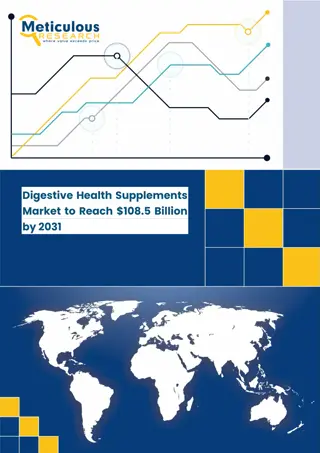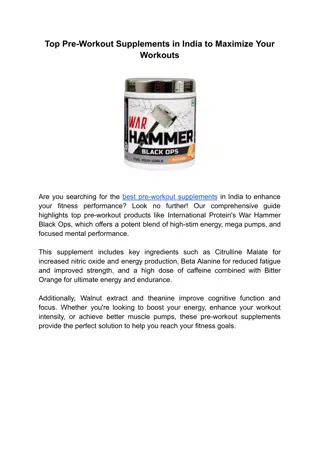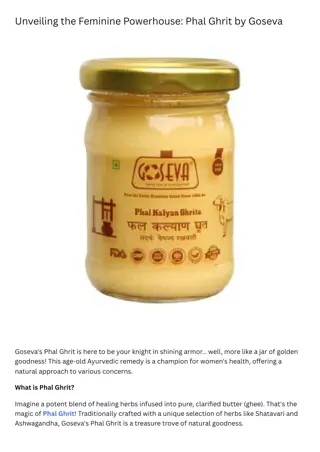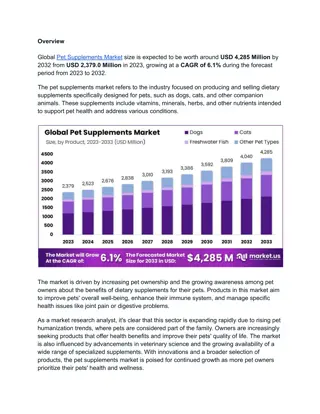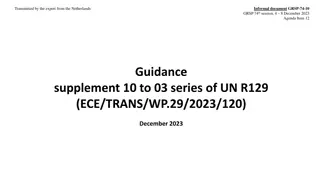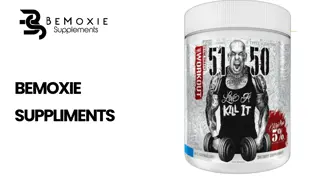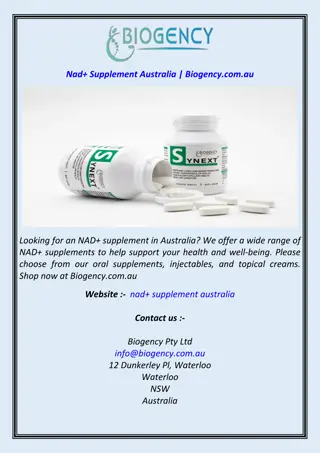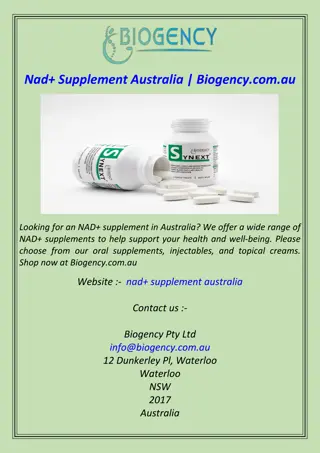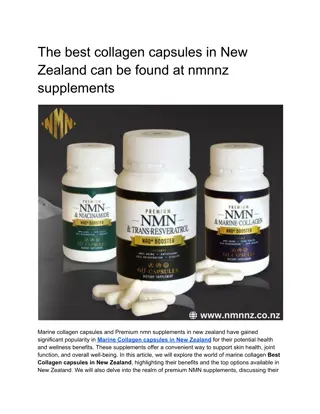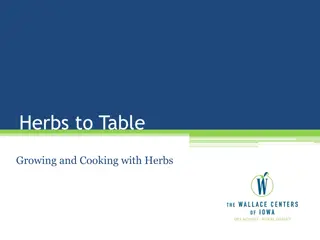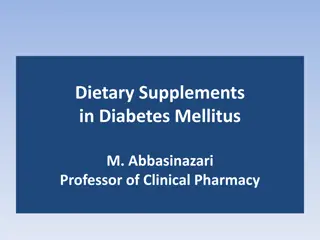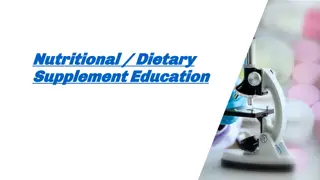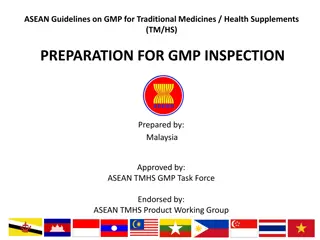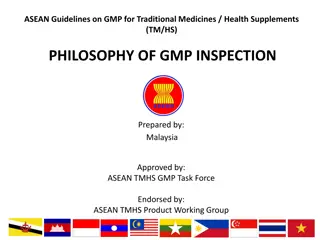Understanding Herbs and Supplements in Healthcare
Plants have been used for medicinal purposes for millennia, with a significant number of people integrating herbs and supplements into their healthcare practices. Patients using these alternative therapies tend to be female, with higher education and income, residing in the Western region. Quality and safety considerations, such as herb-drug interactions and regulations, play crucial roles in the use of herbs and supplements.
Download Presentation

Please find below an Image/Link to download the presentation.
The content on the website is provided AS IS for your information and personal use only. It may not be sold, licensed, or shared on other websites without obtaining consent from the author. Download presentation by click this link. If you encounter any issues during the download, it is possible that the publisher has removed the file from their server.
E N D
Presentation Transcript
HERBS AND SUPPLEMENTS REETU GREWAL, MD COMMUNITY HEALTH & FAMILY MEDICINE UF HEALTH JACKSONVILLE
INTRODUCTION Plants have been used for medicinal purposes for thousands of years Saw palmetto was used for urinary symptoms in men from Egypt in the 15th century BC Hippocrates documented the use of St. John's wort for mood ailments in the 5th century BC Many conventional medications are derived from plant species Codeine (Poppy--Papaver somniferum) Digoxin (Foxglove--Digitalis purpurea) Salicylic Acid (Willow bark--Salix purpurea) Taxol (Pacific yew--Taxus brevifolia)
INTRODUCTION Data from the 2007 National Health Interview Survey show about 40% of US residents integrate 1 or more of these unconventional health practices into their personal health care, spending about $34 billion per year out of pocket Useage worldwide is much higher than in the US
PATIENTS WHO USE HERBS/SUPPLEMENTS Female gender Higher education Higher household income Western region of residence Hispanic or non-hispanic minorities Individuals who had more positive self-reported health status
QUALITY Plant species used (multiple strains of Echinacea) Plant part used Harvesting and storing Processing (drying, alcohol extraction, pressing out juice) Purity (heavy metals, toxins)
SAFETY Herb-Drug Interactions St Johns Wort inhibits CYP450 Grapefruit Juice inhibits CYP450 No Herbs if on Warfarin Lack of Evidence, Poor Quality Studies Not regulated by the FDA Regulation is based on the Dietary Supplement Health and Education Act (DSHEA) of 1994 This act was passed to make natural medicine available to the population at a faster rate then if they went through the rigorous testing of the FDA
SAFETY USP United States Pharmacopial Convention A scientific nonprofit organization that sets standards for the identity, strength, quality, and purity of medicines, food ingredients, and dietary supplements manufactured, distributed and consumed worldwide, 900 + volunteer experts Contains the ingredients listed on the label, in the declared potency and amounts. Does not contain harmful levels of specified contaminants. Will break down and release into the body within a specified amount of time Has been made according to FDA current Good Manufacturing Practices using sanitary and well-controlled procedures
GLUCOSAMINE AND CHONDROITIN #1 Supplement sold in the US Produced by the body Most studies are relatively short duration GAIT Trial (DBPCT) 600+ pts Initial trial 24 weeks, evaluated G (500 mg TID), CS (400 mg TID), and together vs celecoxib (200 mg Q day) and placebo Results looked promising for G and CS together for moderate to severe arthritis Continued study for 2 years No significant improvement Side effect: GI
PROBIOTICS Most common are Lactobacillus and Bifidobacteria, in powders, capsules, yogurts, suppositories No reviews for claims other than diarrhea (boosting immunity) Prevention of Antibiotic Associated Diarrhea 2012 Meta-analysis; RDBPCTs; 34 studies, 4K pts Tx all infections RR 0.53, NNT 8 Tx H pylori infection RR 0.36, NNT 5 Prevention of C diff associated diarrhea RCTs of adults and peds patients, Meta-analysis of 20 trials, ~ 4K pts, any strain, any dose 13 of the trials were lacking data on C difficile outcomes Moderate quality evidence suggest benefit
ZINC Inhibits rhinovirus in vitro Lozenges, Tablets, Liquid; Previously sold as intranasal swabs Side effects: nausea, vomiting, metallic taste Cochrane Review: 1966-2013; Prevention and treatment RDBPCT using Zn at least 5 days for tx or >5 months for prevention 16 therapeutic trials: 1400 pts; significant effect on duration of cold if started within 24 hours, no effect on severity, need to take >75 mg/day 2 preventive trials: insufficient data to make a recommendation Author s Conclusion: Zinc is effective for treatment if started early, needs >75 mg/day
VITAMIN C Generally recommended dose of 1-3 gm/day Side effects: diarrhea Cochrane Review 2010-2012; Prevention and Treatment of Colds RCTs using greater than 0.2 gm/day Prevention Trials: 29 studies, >10K pts; Risk Ratio was 0.97 with vitamin C Treatment Trials Regular (daily) supplementation: 31 studies, ~10K pts; Adults showed decrease in duration by 8%, children showed decrease of 18%; severity of sx was also decreased Treatment Trials (therapeutic): 7 studies, no effect on duration or severity of symptoms Author s Conclusion: Vitamin C is effective for treatment when taken daily during season
HONEY Used as a treatment for cough DBPCRS of 300 children, ages 1-5, given 1 of 3 types of honey (10 gm) or placebo in a single dose and compared to no medication the previous night Evaluated cough frequency, severity and sleep quality of parents and children All interventions (placebo included) showed statistically significant improvement in sx, however the honey tx groups had greater improvement than placebo Author s Conclusion: Honey may be an effective tx, more studies are needed Pediatrics, 2012
CINNAMON In animals attenuation of diabetes associated weight loss, reduction of fasting blood glucose, LDL and HbA(1c) , increasing HDL cholesterol and increasing circulating insulin levels tsp per day of raw cinnamon or 1-6 gm /day of cassia cinnamon (PL) Conflicting Data of Evidence J Clinical Nutrition review 2001-2011 Meta-analysis of 6 RCTs, from 40days-4 months, doses from 1-6 g/day Decrease in HbA1c 0.09% statistically significant Cochrane review up to 2011 10 RCT, 500+ pts, 4-16 weeks High risk of bias in all trials (selection, attrition, blinding), poor quality No evidence of effectiveness
SOY (ISOFLAVONES) Used for tx of menopausal symptoms Soy is a phytoestrogen, phenolic ring binds to estrogen receptor, are about 100-10K x weaker than endogenous estrogen Side effects: GI upset, taste intolerance Cochrane review, 1966-2004 RPCT at least 4 weeks in duration, 25 trials, >2K pts, avg age 53 Soy foods/beverages/powders (11) Maybe beneficial but small trend Soy Extracts (9) No Effect Red Clover (5) No effect
COENZYME Q10 (UBIQUINONE) Important in muscle metabolism, decreased during statin therapy 2007 JACC Systematic Review Numerous studies show supplementation raises circulating levels of CoQ10 Only 2 studies evaluating effect on myalgias, small and not well designed Not beneficial for myalgia treatment 2012 Systematic Review on tx of myalgias with statin use 3 RCTs; 2 of good quality , 1 poor 2 studies showed decrease in pain scores although not statistically significant, 1 study showed no difference Authors conclusion: may be beneficial for patients with mild symptoms
SAW PALMETTO (SERENOA REPENS) The proposed mechanisms of action include 5-alpha reductase inhibition, intraprostatic androgen receptor blockage, and adrenergic receptor antagonism. Mild GI side effects, URI Most common doseage is 160 mg BID 2002 Cochrane Review 21 trials ranging from 4-48 wks, 3K pts; nocturia reduced, improvement of sx Methodological problems noted within the trials included lack of standardized symptom scores and short study durations
SAW PALMETTO STEP Trial (NIH funded) RPCT USP formulated product, 225 pts, 1 year study Used AUA scores for symptoms No difference in placebo vs. saw palmetto CAMUS Trial evaluated saw palmetto on psa Stepped therapy starting at 160 mg BID and increasing Q 6 months 300 patients, evaluated at 24, 48 and 72 weeks No effect on PSA
RESOURCES FOR PROVIDERS NIH National Center for Complementary and Alternative Medicine http://nccam.nih.gov/ Medline Plus http://www.nlm.nih.gov/medlineplus/druginfo/herb_All.html Prescribers Letter
REFERENCES www.uptodate.com Briggs JP, Killen J. Perspectives on complementary and alternative medicine research. JAMA. 2013 Aug 21;310(7):691-2. www.USP.org Linde K, Berner MM, Kriston L. St. John s wort for major depression.Cochrane Database Syst Rev. 2008;(4):CD000448 Linde K, Barrett B, Bauer R, Melchart D, Woelkart K. Echinacea for preventing and treating the common cold. Cochrane Database of Systematic Reviews 2006, Issue 1. Hemil H, Chalker E. Vitamin C for preventing and treating the common cold. Cochrane Database of Systematic Reviews 2013, Issue 1 Singh M, Das RR. Zinc for the common cold. Cochrane Database of Systematic Reviews 2013, Issue 6. Cohen HA, Rozen J, Kristal H, et al. Effect of honey on nocturnal cough and sleep quality: a double- blind, randomized, placebo-controlled study. Pediatrics. 2012; 130(3): 465-471. Schmidt M, Thomsen M, U Schmidt. Suitability of Ivy Extract for the Treatment of Paediatric Cough. Phytother Res. 2012 26:1942 1947.
REFERENCES Roongroj Bhidayasiri, Stanley Fahn, William J. Weiner, et alAmerican Academy of Neurology Report of the Guideline Development Subcommittee of the Evidence-based guideline: Treatment of tardive syndromes: Neurology 2013;81;463-469 Sawitzke AD, Shi H, Finco MF, et al. Clinical efficacy and safety over two years use of glucosamine, chondroitin sulfate, their combination, celecoxib, or placebo taken to treat osteoarthritis of the knee: a GAIT report. Ann Rheum Dis. 2010; 69 (8) 1459-1464. Videlock EJ, Cremonini F. Meta-analysis: probiotics in antibiotic-associated diarrhea. Alimen Pharmacol Ther. 2012; 35(12): 1355- 1369. Johnston BC, Ma SS, Goldenberg JZ, et al. Probiotics for the prevention of Clostridium difficile-associated diarrhea: a systematic review and meta-analysis . Ann Intern Med. 2012 Dec 18;157(12):878-88. Videlock EJ, Cremonini F. Meta-analysis: probiotics in antibiotic-associated diarrhea. Aliment Pharmacol Ther 2012 GL Andriole et. Al. The Effect of Increasing Doses of Saw Palmetto Fruit Extract on Serum Prostate Specific Antigen: Analysis of the CAMUS Randomized Trial . The Journal of UrologyVolume 189, Issue 2, February 2013, Pages 486 492. Bent S, Kane C, Shinohara K, et al. Saw palmetto for benign prostatic hyperplasia. N Engl J Med 2006;354:557 66 http://nccam.nih.gov/ Reinhart KM, Woods JA.. . Strategies to preserve the use of statins in patients with previous muscular adverse effects. Am J Health Syst Pharm. 2012 Feb 15;69(4):291-300
REFERENCES Reinhardt KM, Woods JA. Strategies to preserve the use of statins in patients with previous muscular adverse effects. Am J Health-Syst Pharm. 2012; 69: 291-300. Marcoff L, Thompson PD. The role ofcoenzyme Q10 in statin-associated myopathy.A systematic review. J Am CollCardiol. 2007; 49:2231-7 Akilen R, Tsaiami A, Devendra D, Robinson N. Cinnamon in glycaemic control: Systematic review and meta analysis. Clin Nutr. 2012 Oct;31(5):609-15. Ranasinghe P, Jayawardana R et al. Efficacy and safety of 'true' cinnamon (Cinnamomum zeylanicum) as a pharmaceutical agent in diabetes: a systematic review and meta-analysis. Diabet Med. 2012 Dec;29(12):1480-92. Leach MJ, Kumar S. Cinnamon for diabetes mellitus. Cochrane Database Syst Rev. 2012 Sep 12;9




